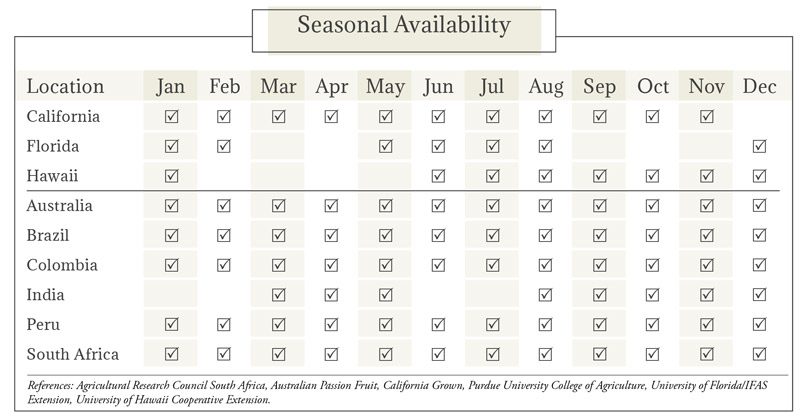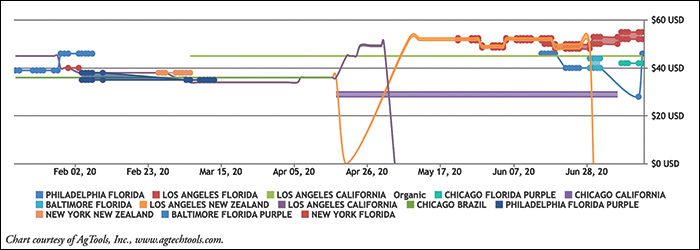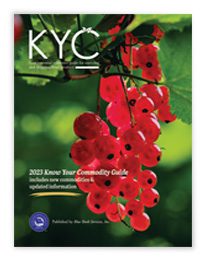Passion Fruit Market Summary


Image: naluwan/Shutterstock.com
Passion Fruit Market Overview
Passion fruit is thought to be indigenous to tropical and subtropical countries in the Americas, specifically Brazil, Paraguay, and Northern Argentina. The fruit is also grown in the United States in California, Florida, and Hawaii. The Passifloraceae family has over 550 species, although only one is known as passion fruit (Passiflora edulis). Passion fruit plants have distinctively beautiful flowers that are cultivated for both edible and aesthetic uses. The plant was named by missionaries who related the structure of the flowers to the Passion of Christ. Passion fruit grows to the size of a tennis ball and can be oval or round. The fruit varies from purple to yellow or orange and features a thick protective rind of about a quarter inch. Inside the rind, numerous seeds are covered in a sweet-acidic pulp, both of which can be consumed. Passion fruit can be eaten fresh, but is more often strained through cheesecloth or boiled down and made into a juice or syrup to flavor everything from cakes, pies, candy, cocktails, ice cream, sorbets, jellies, sauces, and more.
Types & Varieties of Passion Fruit
The primary species, P. edulis, is known as the purple form yet there is also the yellow subspecies, P. edulis var. flavicarpa. The majority of cultivars are derived from the purple or as a yellow-purple hybrid. There are few recommended yellow cultivars, but they are more sensitive to diseases and frost. Within the same family of Passiflora, the Giant Granadilla is also cultivated. Purple cultivars include Australian Purple, Common Purple, Black Knight, Bountiful Beauty, Edgehill, Frosty, Kahuna, Nancy Garrison, Paul Ecke, and Purple Giant. Yellow-purple hybrids are Frederick, Pratt Hybrid, Red Rover, and Red Riviera.

Cultivation of Passion Fruit
Passion fruit plant is a vigorous vine that can climb as high as 30 feet, typically growing best in sandy loams and fast draining soils to prevent disease in its shallow roots. The vine grows well in humid, tropical, and subtropical climates, but will not tolerate multiple freezes. All three primary passion fruits can be planted from seed (preferably fresh), cuttings, or grafted. Preparing trellises is an important part of production, with vines planted 10 to 15 feet apart in 15 to 20 feet rows (or in similar arrangement to grape cultivation). Pruning is necessary as plants grow extensively and often tangle. Purple varieties typically self-pollinate while yellow varieties must be dusted with pollen from a compatible vine. Passion fruit should be harvested when ripe and ready to drop with gentle prodding. Unripe fruit can have what is often described as a ‘woody’ taste. Ripeness indicators include color (shifting from green to purple or yellow), the condition of the skin (slight wrinkling), and size (fruit is between 1.5 to nearly 3 inches in diameter). Moisture loss or shriveling of the outer skin typically does not affect the flesh.
Pests & Diseases Affecting Passion Fruit
The passion vine mite defoliates younger vines and leads to brown blemishes on the fruit in warm, dry seasons. Nematodes often invade the roots of plants, leading to the development of cankers and stem lesions. Thrips cause damage to young plants or seedlings and can lead to stunting. The fungi phytophthora and fusarium typically affect roots, leading to unhealthy vines at the soil line. The fungi can be avoided by grafting a purple variety onto a resistant yellow variety. Purple varieties are commonly affected by the above pests and diseases and thus must be replanted every 3 to 4 years. Both purple, yellow, and hybrid varieties are at risk from viruses, any plant exhibiting mosaic or vein-clearing is contagious and should be destroyed.Storage & Packaging of Passion Fruit
Storage for partially ripe fruits is recommended at 45 to 50°F, which will extend shelf life to 3 to 5 weeks. Fully ripe fruit should be stored at 41 to 45°F for up to 1 week. Relative humidity of 90 to 95% is recommended. When kept at temperatures of 41°F or lower, chilling injury may occur, leading to external and internal discoloration, pitting, decay, water-soaking, and uneven ripening, or a failure to ripen at all. Packaging fruit in perforated plastic film is recommended to reduce water loss during handling. References: California Rare Fruit Growers Inc., Purdue University, UC Davis Postharvest Technology website, University of California Agriculture & Natural Resources, University of Florida/IFAS Extension.Grades & Good Arrival of Passion Fruit
There is no grade information for passion fruit at this time. Currently, there are no good arrival guidelines published for this commodity.Passion Fruit Terminal Market Pricing: Single Layer Carton, 28s



